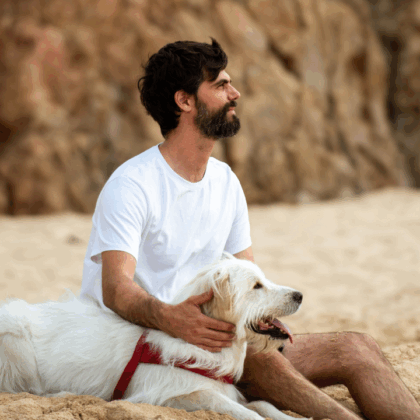One key reason I developed Really Real Relaxation is that I got angry watching a trainer teach a dog to relax. What they meant by relax was laying down with head on the ground between the paws and not moving at all, no matter what happened. If the dog lifted his head to look at the trainer who was stomping all around the dog, a big correction was forthcoming. It didn’t take long for the dog to figure out there was only one right answer: lay still, don’t move, keep head down no matter what.
You can imagine what that dog looked like: shut down, inhibited, anxious. But the trainer was delighted with the results. I felt so badly for that poor dog, and knew there had to be much better ways to help a dog relax.
So I began watching all the animals in my life, looking to see how and when and where they relaxed, and when they did not relax. I wanted to know how they looked when they were relaxed, and what interfered with relaxation. Whether my little flock of chickens or my Amazon parrot, my horses, donkey, cats, or my dogs, they all taught me the same thing: relaxation happened when those around them were also relaxing. Yet no other animal signaled “RELAX!” The animal I was watching simply made the choice to relax, and brought themselves into a quiet state.
There’s a world of difference between a dog who’s been told to lie DOWN and a dog who chooses to relax. One is compliance with a cue; the other is a physiological shift that affects everything from hormone levels to immune function. Understanding this distinction is crucial for anyone seeking to help their dog achieve Really Real Relaxation (RRR).
When we prompt a DOWN, we’re asking for a physical position. The dog’s body may be horizontal, but their mind often remains on high alert. Think of it like forcing yourself to lie in bed when you’re wired—your body is still, but your nervous system is anything but calm. As any insomniac knows, simply laying in a resting position does not equal relaxation! (If only it did . . .) While some relaxation protocols seem to think that staying down will inevitably lead to relaxation, my experience says otherwise. What I see is this: Muscles stay subtly tense, ears track every sound, and the dog remains ready to spring into action. When released, the dogs spring up.
Really Real Relaxation, by contrast, is a choice your dog makes when they feel safe enough to genuinely down-regulate their arousal level. This isn’t about obedience—it’s about trust and emotional regulation. A dog in RRR has made the conscious decision that activity or vigilance isn’t needed right now. Their muscles begin to soften, breathing slows and deepens, and their entire system shifts into rest-and-digest mode.
The element of choice is critical and the key to RRR. Relaxation is fundamentally a neurological state, not a behavior. You can’t command someone’s parasympathetic nervous system to activate any more than you can order someone to fall asleep. These states emerge when conditions feel safe and conducive.
Through Relationship Centered Training, we understand that our role isn’t to force relaxation but to create the conditions where our dog can make the choice to relax. While that sounds simple, RRR asks us to address the dog’s underlying sense of safety, their trust in us, and their own capacity for self-regulation.
The beautiful thing about choice-based relaxation is its authenticity. The genuine shift in arousal is unmistakable. The dog who chooses relaxation moves with fluid grace, settles gradually, and maintains soft, peaceful body language. The dog following a command often maintains subtle tension, even in a DOWN position.
Real relaxation is always a gift to you and your dog.

